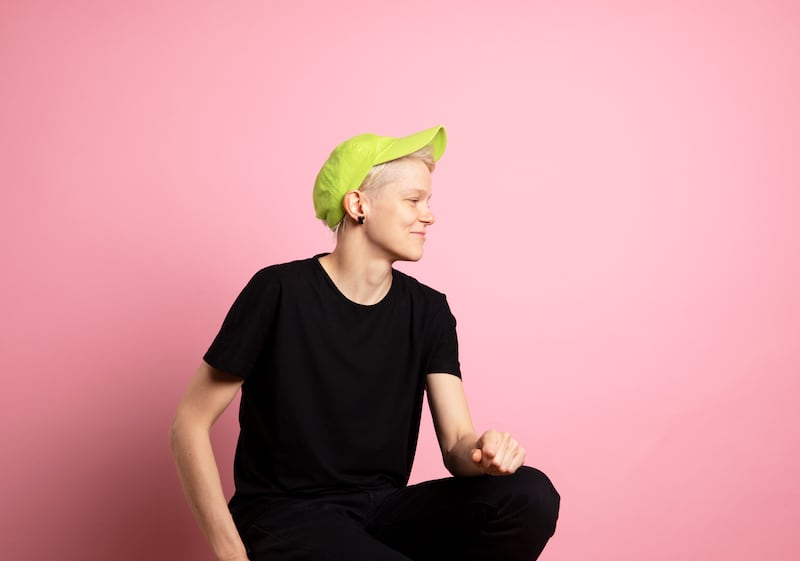All jazz musicians are, to a lesser or greater extent, singular. It’s a form in which individuality of expression – having your own style, approach and voice – is hardwired into the process and practice; it is celebrated in every note and phrase, and on every tune. The great American improvising and classical pianist Keith Jarrett once said, “What jazz signifies to me is the freedom to be yourself.”
Linda Fredriksson, however, is something again. The Finnish musician is not only a saxophonist, which for non-male jazz players remains rare enough, but also a saxophonist whose main instrument is strikingly not the more common alto or tenor. Fredriksson plays the big, bulky, brassy baritone, an amalgamation of tubes, loops, U-bends, keys, holes, pads, hinges, hooks and rods that looks as if it might have been invented by W Heath Robinson, rather than Adolphe Sax. Fredriksson also uses they/them pronouns and does not identify as either male or female: they may be the world’s first and only non-binary baritone saxophone player.
Even the location of our interview is somewhat unconventional. I had expected Fredriksson to be talking to me from the comfort of their home in Helsinki; when we are connected, however, they are sitting on the ground, by the bike racks, outside the Finnish capital’s central railway station. At times they have to break off to make way for a cyclist or skateboarder.
“I’m in a bit of a funny place, but don’t worry, I’m here with you,” they say, good-naturedly and in perfect English. “I’m blocked in, and we finally have spring here in the city, so it’s quite nice and relaxed.” Fredriksson is at once a musical trailblazer, gender nonconformist and interviewee original.
New homes: comprehensive guide to what’s for sale in Dublin, Wicklow, Kildare, Meath, Cork and around the State
‘They’re supposed to represent us, not sue us’: Crafts council threatens members after critical feedback
If Robert De Niro no longer feels he is able to speak out, one wonders who in the US does
‘The situation’s changed, but in Finland when I was a student you had the freedom and funding to study for as long as you wanted’
This month Fredriksson and their quartet will be blazing a trail around Ireland, as part of an eight-date Music Network tour that takes in Dublin, Cork and Waterford but also smaller places such as Belmullet in Co Mayo, and Tinahely in Co Wicklow. Although this is not their first time playing in Ireland – they have performed with the European Saxophone Ensemble and the jazz-punk trio Mopo, for example – this will be Fredriksson’s first time appearing outside Dublin. I tell them some of the venues are in small towns; they seem enthusiastic.

“In general, when I write and play music, I always appreciate more the opinions of people who are listeners and not musicians,” says Fredriksson. “If I’m able to reach somebody who is not, you know, a jazz enthusiast or nerd, then, to me, it’s a sign that the music is not about genre, or the framework around a particular genre. It’s more that there is some energy or emotion that I’ve been able to transmit or share. For me, that’s the best possible goal.”
Fredriksson, who is 39, grew up in Helsinki; their mother was an art teacher and their father worked in social housing – both are now retired. No one in their wider family was particularly musical, though Linda’s older brother played flute and guitar and sang in a band. “When I was small, my big brother was my big inspiration – that’s how I got the idea to start playing,” says Fredriksson. “He stopped in high school, and I carried on.”
At the age of eight they applied to the city’s classical conservatory, but failed to get in. “Maybe I was too wild,” Fredriksson says. “I had a lot of energy and creative ideas, and I was often in detention at school. One time, when our teacher was out of the room, I pretended there was a fire drill and encouraged all my classmates to jump out of the window. We were on the ground floor, though.”
The following year they were accepted at Helsinki’s forward-thinking Pop & Jazz Conservatory; they fitted in far better but still showed signs of being somewhat headstrong, of going against the grain. “I’d decided to play clarinet, because there was a clarinettist in my brother’s band, but then everyone else around my age, especially the girls, seemed to be choosing that,” says Fredriksson. “I clearly remember that I didn’t want to play the same instrument as everybody else; I wanted to have a thing of my own. So I choose the alto saxophone.”
They listened to all kinds of music as a teenager, but in particular to funk, soul and R&B – acts such as Erykah Badu, Jamiroquai and James Brown; the Godfather of Soul’s saxophonist for many years, Maceo Parker, remains one of their favourites. Fredriksson was increasingly pulled towards jazz, however, especially by the saxophonists John Coltrane and Jan Garbarek – the latter’s work in Keith Jarrett’s 1970s Scandinavian Quartet remains crucial to them.
Fredriksson enrolled on the jazz course at the renowned Sibelius Academy in their late teens, had a year at Amsterdam Conservatory as an exchange student, and spent much of their 20s studying saxophone and music education, gaining a master’s degree in 2014. “The situation’s changed, but in Finland when I was a student you had the freedom and funding to study for as long as you wanted.”
They first played the baritone aged 19, when they were asked to sub for the saxophonist in a Helsinki Afrobeat band. “It was honestly love at first sight,” says Fredriksson. “I was quite blocked with the alto at the time, and the joy seemed to have gone out of playing it, but suddenly I felt open and free – that I could find my own way again. I knew immediately that this would become my main instrument. There is such a huge range of sounds and emotions you can express on the baritone – from soft and tender, and sweet and beautiful, to roughness, horror, terror and pain.”
‘I like to imagine that I am singing when I’m playing, because it makes it easier for me to connect to the mood and emotion of the song’
Although the baritone has a long and continuing tradition in jazz – celebrated players include Harry Carney, Gerry Mulligan, John Surman and Hamiet Bluiett – and occasionally beyond, in the hands of saxophonists such as Dana Colley of Morphine and LeRoi Moore of the Dave Matthews Band, Fredriksson remains an anomaly. Their only material role model was Lisa Simpson.
“So, of course, I soon started getting comments like, ‘How can a person so small’ [Fredriksson is 165cm tall, or 5ft 5in] be playing an instrument so huge?’, which by now is a question I’ve heard, like, a hundred million times.”
During and after their academic studies Fredriksson played with many bands, including the fiery jazz quartet Superposition, the acclaimed UMO Helsinki Jazz Orchestra, the jazz-rap ensemble Ricky-Tick Big Band and soul-jazz group the Northern Governors.
Perhaps most prominent among them, and certainly most playful, was Mopo, the energetic outfit they cofounded in 2009. The sax-bass-drums power trio released five albums; live shows sometimes saw Fredriksson playing alto and baritone simultaneously, the trio switching instruments mid-song and band members wandering into the audience to make duck calls and “play” squeaky toys.
“If I hadn’t played in Mopo, and had these two friends beside me, I wouldn’t be doing what I’m doing now,” they say. “It was this fun and free safe space that made it possible for me to find my own voice and to start to look for who I am.”
Fredriksson increasingly contributed their own music to Mopo, as they had for various theatre, silent-film and performance-art projects, and by 2021 they felt ready to release a debut album, Juniper, on the enterprising Finnish label We Jazz.

An album of original compositions played by Fredriksson and a versatile Finnish trio of Tuomo Prättälä on keyboards and two of Fredriksson’s bandmates in Superposition, Mikael Saastamoinen on double bass and Olavi Louhivuori on drums, Juniper takes inspiration from the spiritual jazz of Alice Coltrane and Pharoah Sanders, the radical edge of the alto saxophonist Eric Dolphy, and singer-songwriters such as Neil Young, Feist, Beck and Sufjan Stevens, specifically his landmark 2015 album, Carrie & Lowell. According to the blurb, “at heart, Juniper is a singer-songwriter album performed by an instrumental jazz band”.
“I like to imagine that I am singing when I’m playing, because it makes it easier for me to connect to the mood and emotion of the song,” Fredriksson says. “And I’ve definitely listened to more singers than saxophonists.”
Juniper is also a very personal statement. The integration of Fredriksson’s lo-fi field recordings of gentle guitar picking, quiet rainfall and friendly conversation gives the album an intimate feel; subjects range from the death of their grandmother to the restorative power of nature; and the tunes are strongly melodic, rhythmic and, at times, ambient, even cinematic; it is a clever, contemplative record that conjures up many images, sensitivities and spirits. You somehow feel you are inside the music.
It was also a great success in Finland, winning prizes and awards, and selling well, even reaching high into the pop charts. In doing so, Fredriksson and Juniper have become a force for positive change.
“There was definitely a lot going on in my life when I was making the album, like not categorising myself and letting myself be who I am, and letting the music be what it is outside of all the boxes and genres that I don’t fit into,” says Fredriksson. “In the same way that I see myself as not a woman or a man or even non-binary – I am a human being – Juniper is not jazz or anything else; it’s just music. You can exist in this world in so many ways.”
Linda Fredriksson plays Juniper in Mayo, Sligo, Donegal, Dublin, Waterford, Wicklow, Cork and Kildare between Friday, June 7th, and Saturday, June 15th, on a Music Network tour


















